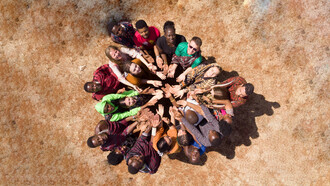Knowing is the perceptual process that allows us to relate to what is around us, extending into thoughts that refer either to the past, the present, or the future. This process sometimes makes the nonexistent exist through sight and hearing, which highlights the word since this existence can only take place through it. The word is then significant despite having no density, shape, or color (although according to empiricists and causalists, these criteria determine what exists). Sometimes the meaning of the world does not match what is considered real, that is, that which can be seen, held, smelled.
Language is the expression of the perceived and not its determinant. The word does not create the world, instead it reflects, expresses, and even organizes trails that encompass the perceived, the structured, and eventually subdivides it. When words refer to what does not exist, they result from other experiences, from globalization that can generate explanatory concepts and statements as much as it can fuse experiences and meanings, thus creating true conglomerates that hide experiences and realities.
Globalizations of the existing through conceptualizations allow to recognize life and density even in the metaphor. Fantasizing, raving, and inventing are also ways of expressing meanings, which can be later globalized and conceptualized. This spiral of time allows for new apprehensions, new references, new perceptions, and thus several concretions just imagined start signifying and being perceived, making up the so-called knowledge of things - the perception of the perceived.
Words often express what does not exist, playing the role of imagination, of fantasy. The phrase “the lightness of the air and the freshness of your presence...”, which is very used, allows knowledge of what is meant, but does not bring any explicit density to the direct, palpable knowledge. This always assumes and needs a dense relational platform. In this case, memory is fundamental to make language links explicit. All of this leads us to admit that verbal knowledge does not occupy a place in space: it is distant from this spatial relationship. What takes place is the concept, the globalization, as much as fantasy, chimera, delirium. This sets up our daily dealings with words, objects, affirmations, statements, beliefs, and values. Words indicate, summarize, but have no counterparts, since the referential is not always dense, concrete. The question of existence in the form of concreteness is one of the epistemological and theological-religious puzzles. The need for manifestation, for proof of the divine, constitutes an equivalent of the factual proof necessary in some stages of scientific thought. Chomsky says, quoting Humboldt: “A word is not an impression of the object in itself, but rather of its image, produced in the soul”. Reediting the dualism between body and soul, between real and magical, is like “dividing to rule” or to understand that it only establishes distortions.
Starting from the unit and following its directions, we visualize countless configurations, relationships that allow us to say that perception (knowledge) is what structures the meaning, the linguistic, semantic sense, which can be communicated, expressed, and understood. The process of structuring meaning occurs through categorization, that is, perceive you are perceiving. All meanings are structured in the context of perception. Perception is knowledge, and categorization is knowing that you know, perceiving that you perceive, it is the knowledge of the known. In this process, relational networks are structured by closure, proximity, similarity, good shape or pregnancy of the form - in short, according to perceptual laws. The most pregnant form starts to be perceived more often. This frequency is rated positively or negatively according to the established references, that is, points, nodes in the network. Thus, the meaning arises, the knowing that you know. This perceptual relational structure begins to create meaningful maps. The reference, the indication of these significant maps - these perceived meanings - enables communication, language. The significant continuities contextualize sense, direction, perception of perception, knowledge, and other relationships.
Questioning and understanding the strength of the word conveying truths and lies - knowledge and fantasy - is important in the contemporary world dominated by the ease and speed in the circulation of ideas (with its issues of disputes over power, veracity, fake news etc.). These actions are of fundamental importance in psychology and psychotherapy. As I stated on another occasion, speech is a key fingerprint of human beings.
Additional readings complementing this theme
Vera Felicidade, Communicating is remedying. The language is dangerous.
Vera Felicidade, Manipulation and Contemporaneity. The lie has become the world order, Kafka.
Vera Felicidade, Por que linguagem? A fala é uma das digitais mais individualizantes do ser humano (Speech is a key fingerprint of human beings).















